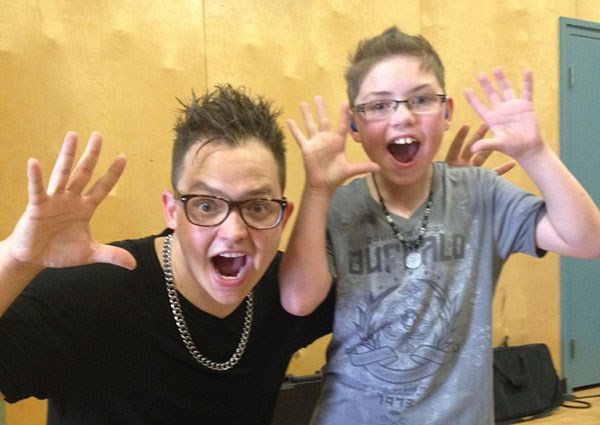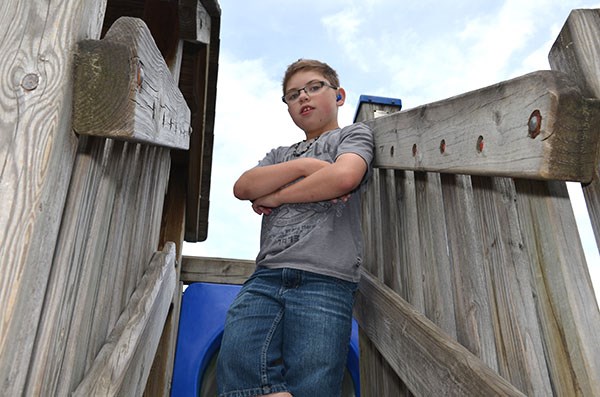Emilio Razzano drops his mountain bike beside the playground to flip through his iPhone playlist. The screen’s reflection flashes across the slight, 11-year-old’s glasses as he studiously scrolls through various rap artists. He stops when he hits Sean Forbes. He turns the volume up – way up – and slips the phone into the pocket of his shorts.
Forbes is one of Emilio’s idols. He’s seen him in concert and had a photo taken with him after the show. Emilio even shaved Forbes’s initials into his short, brown hair. The outgoing boy’s music folder is full of Forbes’s material, and whenever he’s linked up to the Internet, Emilio checks out the Boston-based rapper’s latest videos.
Emilio dreams of following in his favourite star’s footsteps, being onstage rapping in front of a sea of people. This year, with the help of his classmates at Stawamus Elementary School, Emilio made his first music video.
And while most parents cringe at the rhythms and heavy bass that accompanies the hip-hop scene, Emilio’s mother Pam encourages it. Forbes’s music shares some of the same funked-up beats of old school rap. Like many rappers, there’s defiance in his voice when he addresses society’s failings.
There’s also a wallop of inspiration in Forbes’s music, something that at times lacks in the “thug life and broads” big hits. And there’s realism. A realism that makes listeners check themselves and investigate stereotypes they may not have known were there.
Although Forbes and Emilio are 21 years apart, they share similarities – both are Caucasian, with spiky brown hair and glasses. Both are short in stature. The likeness is played up as Emilio emulates his hero’s geek-chic style.
But there’s another factor the young boy and touring artist have in common – they’re both deaf.
“Emilio has five per cent hearing in one ear and seven per cent in the other,” Pam said, explaining that he can’t hear things like talking, but he can pick up on loud bangs or bass.
As an infant, Emilio was diagnosed with hypoplastic left heart syndrome. He had three open-heart surgeries and countless trips to the hospital. His deafness was diagnosed when he was 18 months old.
Emilio is part of the mainstream school system. He jokes with his buddies, plays games with them during lunch, and works alongside them on school projects. Some of Emilio’s friends have learned a bit of American Sign Language (ASL). And like most kids his age, Emilio keeps up with his social life texting on his phone.
Outside of school, Emilio takes classes with Still Dancing. Emilio signs to his mother enthusiastically, communicating how much he loves dancing.
For two years, Sara Stuart has taught Emilio tap and jazz.
“He can feel the beat so proficiently within himself,” she says. “He picks it up so quickly. He is never off beat with
the music.”
While Emilio took to the moves fast, what Stuart didn’t anticipate was how much he taught her and the class. Stuart has learnt to teach non-verbally, through demonstrations and showing students to feel the movements through the various parts of their bodies – their toes, heels and arches.
“I found that it has worked with a lot of the other students,” she said.
Since Emilio started class, the previous flow of student questions regarding certain moves has slowed. Taking queue from Emilio, pupils try the moves first, going through the paces and watching the steps before taking to discussion.
“Emilio has been an awesome tool and he doesn’t know it,” Stuart said.
Although he’s done jazz and tap, Emilio’s favourite dance genre is freestyle. Back in the park, he breaks out a few steps, as he signs to his mother that hip-hop is the best. His shoulders bounce in rhythm to the bass pumping from his phone to his blue hearing aids. He doesn’t miss a note; his body moves fluidly as he feels the music.
The links between music and the non-hearing world are nothing new, says Janice Lyons, head of interpreting services for the Western Institute for the Deaf and Hard-of Hearing in Vancouver. There’s the famous composer Ludwig van Beethoven, but in the MTV-era there have been deaf musicians entertaining teens for years, Lyons noted. When she was growing up, the big star was German-born Bob Hiltermann, who formed an all-deaf rock band in the late ’80s.
Today’s technology is changing the scene for deaf musicians, Lyons said. Thanks to YouTube, the hearing and non-hearing world are able to find all kinds of artists at the touch of a button. That kind of exposure helps the deaf community build upon ideas; encouraging individuals to branch out. Technology like Facebook, closed captions, Facetime and texting is blending the communities, said Lyons, who invented Canada’s first 911 texting service.
Just as if not perhaps more importantly, is that hearing people become interested in learning to sign, she added.

It’s a big turnaround, Forbes noted in an email to the Squamish Chief. For centuries, the deaf community faced oppression. They fought for recognition, for their culture and for their language.
Today, the community has made great strides addressing accessibility with the help of technology, Forbes says. Television shows like ABC Family’s Switched At Birth are pulling the non-hearing community into the hearing community. Launched in 2011, the teen drama was the first mainstream series to include multiple deaf and hard-of-hearing characters. And as more people are exposed to the deaf culture, Forbes hopes they’ll want to be a part of cool community and language.
Like Emilio, Forbes wears a hearing aid that amplifies sound, helping him pick up on bass, drums and sometimes guitar. And like Emilio, he can’t hear high-frequency noises. But Forbes believes he interprets music much like it sounds to hearing people – it’s all about the feeling. As with all music lovers, it’s the mood of a piece that enthralls him.
“The feel of a song is what makes you want to ‘listen’ to it,” Forbes says.
With the help of rap super star Eminem’s publisher Joel Martin, Forbes founded the Deaf Professional Arts Network (D-PAN) four years ago. The non-profit organization makes music accessible to the deaf and hard-of-hearing community. The team’s first ASL music video, Where’d You Go, by Fort Minor generated hundreds of thousands of YouTube views. Since 2011, the organization has covered more than 10 artists, including John Mayer, Eminem and The White Stripes.
Forbes’s own work can be heard on NPR. He’s got a following made up of some heavy hitters, including world-renowned author Mitch Albom. Forbes regularly speaks on TV and radio programs promoting awareness. He’s also working on his next record.
Forbes wants to be known as a rapper and just a rapper. His music has fans in both worlds. He’s opened eyes and inspired the next generations, youth like Emilio, to go further.
“Ultimately, if anything can bring the two communities together, the hearing and the deaf, it’s music … and that’s what I want.”



